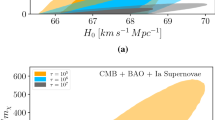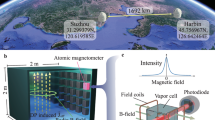Abstract
The 21 cm signal from the dark ages provides a potential new probe of fundamental cosmology. While exotic physics could be discovered, here we quantify the expected benefits within the standard cosmology. A measurement of the global (sky-averaged) 21 cm signal to the precision of thermal noise from a 1,000 h integration would yield a measurement within 10% of a combination of cosmological parameters. A 10,000 h integration would improve this measurement to 3.2% and constrain the cosmic helium fraction to 9.9%. Precision cosmology with 21 cm fluctuations requires a collecting area of 10 km2 (corresponding to 400,000 stations), which, with a 1,000 h integration, would exceed the same global case by a factor of ~2. Enhancing the collecting area or integration time by an order of magnitude would yield a 0.5% parameter combination, a helium measurement five times better than Planck and a constraint on the neutrino mass as good as Planck. Our analysis sets a baseline for upcoming lunar and space-based dark-ages experiments.
This is a preview of subscription content, access via your institution
Access options
Access Nature and 54 other Nature Portfolio journals
Get Nature+, our best-value online-access subscription
$29.99 / 30 days
cancel any time
Subscribe to this journal
Receive 12 digital issues and online access to articles
$119.00 per year
only $9.92 per issue
Buy this article
- Purchase on Springer Link
- Instant access to full article PDF
Prices may be subject to local taxes which are calculated during checkout



Similar content being viewed by others
Data availability
The data are available upon request from the corresponding author. Source data are provided with this paper.
Code availability
CAMB is available at http://camb.info, emcee is available at https://github.com/dfm/emcee and corner is available at https://github.com/dfm/corner.py. The analyses were performed in Python using publicly available routines in NumPy (https://numpy.org) and Matplotlib (https://matplotlib.org). All other codes used are available upon request from the corresponding author.
References
Sunyaev, R. A. & Zeldovich, Y. B. Formation of clusters of galaxies; protocluster fragmentation and intergalactic gas heating. Astron. Astrophys. 20, 189 (1972).
Hogan, C. J. & Rees, M. J. Spectral appearance of non-uniform gas at high z. Mon. Not. R. Astron. Soc. 188, 791–798 (1979).
Scott, D. & Rees, M. J. The 21-cm line at high redshift: a diagnostic for the origin of large scale structure. Mon. Not. R. Astron. Soc. 247, 510 (1990).
Madau, P., Meiksin, A. & Rees, M. J. 21 centimeter tomography of the intergalactic medium at high redshift. Astrophys. J. 475, 429 (1997).
Loeb, A. & Zaldarriaga, M. Measuring the small-scale power spectrum of cosmic density fluctuations through 21cm tomography prior to the epoch of structure formation. Phys. Rev. Lett. 92, 211301 (2004).
Barkana, R. & Loeb, A. Probing the epoch of early baryonic infall through 21-cm fluctuations. Mon. Not. R. Astron. Soc. 363, L36–L40 (2005).
Bharadwaj, S. & Ali, S. S. The cosmic microwave background radiation fluctuations from HI perturbations prior to reionization. Mon. Not. R. Astron. Soc. 352, 142–146 (2004).
Barkana, R. & Loeb, A. A method for separating the physics from the astrophysics of high-redshift 21 centimeter fluctuations. Astrophys. J. 624, L65–L68 (2005).
Naoz, S. & Barkana, R. Growth of linear perturbations before the era of the first galaxies. Mon. Not. R. Astron. Soc. 362, 1047–1053 (2005).
Lewis, A. & Challinor, A. 21cm angular-power spectrum from the dark ages. Phys. Rev. D 76, 083005 (2007).
Ali-Haïmoud, Y., Meerburg, P. D. & Yuan, S. New light on 21 cm intensity fluctuations from the dark ages. Phys. Rev. D 89, 083506 (2014).
Tashiro, H., Kadota, K. & Silk, J. Effects of dark matter-baryon scattering on redshifted 21 cm signals. Phys. Rev. D 90, 083522 (2014).
Muñoz, J. B., Kovetz, E. D. & Ali-Haïmoud, Y. Heating of baryons due to scattering with dark matter during the dark ages. Phys. Rev. D 92, 083528 (2015).
Barkana, R. Possible interaction between baryons and dark-matter particles revealed by the first stars. Nature 555, 71–74 (2018).
Chen, X., Meerburg, P. D. & Münchmeyer, M. The future of primordial features with 21 cm tomography. J. Cosmol. Astropart. Phys. 2016, 023 (2016).
Pillepich, A., Porciani, C. & Matarrese, S. The bispectrum of redshifted 21 centimeter fluctuations from the dark ages. Astrophys. J. 662, 1–14 (2007).
Joudaki, S., Doré, O., Ferramacho, L., Kaplinghat, M. & Santos, M. G. Primordial non-Gaussianity from the 21 cm power spectrum during the Epoch of Reionization. Phys. Rev. Lett. 107, 131304 (2011).
Flöss, T., de Wild, T., Meerburg, P. D. & Koopmans, L. V. E. The dark ages’ 21-cm trispectrum. J. Cosmol. Astropart. Phys. 2022, 020 (2022).
Balaji, S., Ragavendra, H. V., Sethi, S. K., Silk, J. & Sriramkumar, L. Observing nulling of primordial correlations via the 21-cm signal. Phys. Rev. Lett. 129, 261301 (2022).
Bowman, J. D., Rogers, A. E. E., Monsalve, R. A., Mozdzen, T. J. & Mahesh, N. An absorption profile centred at 78 megahertz in the sky-averaged spectrum. Nature 555, 67–70 (2018).
Singh, S. et al. On the detection of a cosmic dawn signal in the radio background. Nat. Astron. 6, 607–617 (2022).
Mertens, F. G. et al. Improved upper limits on the 21 cm signal power spectrum of neutral hydrogen at z ≈ 9.1 from LOFAR. Mon. Not. R. Astron. Soc. 493, 1662–1685 (2020).
Trott, C. M. et al. Deep multiredshift limits on Epoch of Reionisation 21 cm power spectra from four seasons of Murchison Widefield Array observations. Mon. Not. R. Astron. Soc. 493, 4711–4727 (2020).
The HERA Collaboration. Improved constraints on the 21 cm EoR power spectrum and the X-Ray heating of the IGM with HERA phase I observations. Astrophys J. 945, 124 (2023).
Lewis, A. & Bridle, S. Cosmological parameters from CMB and other data: a Monte Carlo approach. Phys. Rev. D 66, 103511 (2002).
Alcock, C. & Paczynski, B. An evolution free test for non-zero cosmological constant. Nature 281, 358–359 (1979).
Ali, S. S., Bharadwaj, S. & Pandey, B. What will anisotropies in the clustering pattern in redshifted 21-cm maps tell us? Mon. Not. R. Astron. Soc. 363, 251–258 (2005).
Nusser, A. The Alcock-Paczyński test in redshifted 21-cm maps. Mon. Not. R. Astron. Soc. 364, 743–750 (2005).
Barkana, R. Separating out the Alcock-Paczyński effect on 21-cm fluctuations. Mon. Not. R. Astron. Soc. 372, 259–264 (2006).
Barkana, R. & Loeb, A. Light-cone anisotropy in 21-cm fluctuations during the epoch of reionization. Mon. Not. R. Astron. Soc. 372, L43–L47 (2006).
Mondal, R., Bharadwaj, S. & Datta, K. K. Towards simulating and quantifying the light-cone EoR 21-cm signal. Mon. Not. R. Astron. Soc. 474, 1390–1397 (2018).
Planck Collaborationet al. Planck 2018 results. VI. Cosmological parameters. Astron. Astrophys. 641, A6 (2020).
Acknowledgements
We thank A. Lewis and L. V. E. Koopmans for their useful discussions. R.M. is supported by the Israel Academy of Sciences and Humanities & Council for Higher Education Excellence Fellowship Program for International Postdoctoral Researchers. We acknowledge the support of the Israel Science Foundation (grant no. 2359/20).
Author information
Authors and Affiliations
Contributions
R.B. initiated the project. R.M. performed the calculations, made the figures and wrote the paper in consultation with R.B.
Corresponding author
Ethics declarations
Competing interests
The authors declare no competing interests.
Peer review
Peer review information
Nature Astronomy thanks Joseph Silk for their contribution to the peer review of this work.
Additional information
Publisher’s note Springer Nature remains neutral with regard to jurisdictional claims in published maps and institutional affiliations.
Supplementary information
Supplementary Information
Supplementary Note
Source data
Source Data Fig. 1
Source data for Fig. 1.
Source Data Fig. 2
Source data for Fig. 2.
Source Data Fig. 3
Source data for Fig. 3.
Rights and permissions
Springer Nature or its licensor (e.g. a society or other partner) holds exclusive rights to this article under a publishing agreement with the author(s) or other rightsholder(s); author self-archiving of the accepted manuscript version of this article is solely governed by the terms of such publishing agreement and applicable law.
About this article
Cite this article
Mondal, R., Barkana, R. Prospects for precision cosmology with the 21 cm signal from the dark ages. Nat Astron 7, 1025–1030 (2023). https://doi.org/10.1038/s41550-023-02057-y
Received:
Accepted:
Published:
Issue Date:
DOI: https://doi.org/10.1038/s41550-023-02057-y



